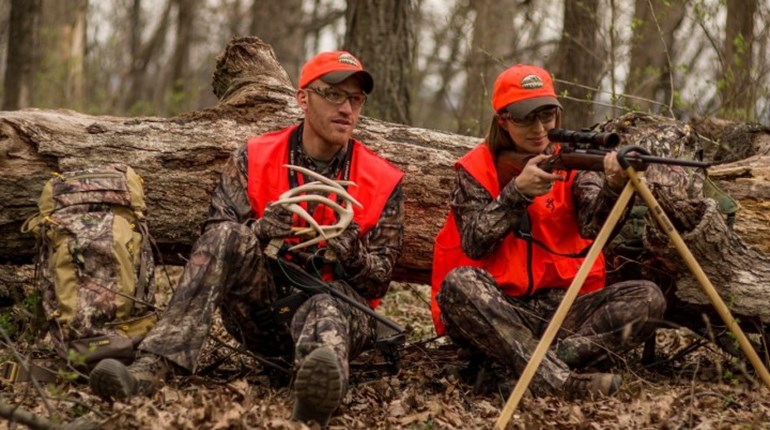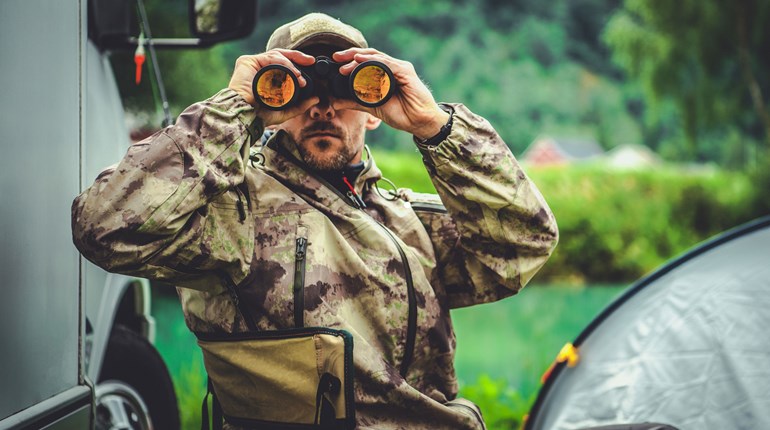People often write to outdoor writers at newspapers and magazines, eager to share memories and photos of their kids’ first deer, turkey or big fish.
With few exceptions, they’re good stories. They’re rich in detail, and packed with love and pride direct from the soul. You sense these folks seldom talk this way in casual conversation, except maybe late at night with loved ones or trusted friends. They must lose such inhibitions when the kid comes of age or fulfills a parent’s heartfelt wish.
Though shared less often, old-timers also tell great stories of their first deer, dropping their voices an octave to imitate their dad’s advice or an uncle’s congratulations. Maybe it’s the lingering odors of wet wool, wood smoke and musty cabins—or whatever loosened their tongues—but these nostalgic tales recount the heroics—and sometimes failings—of men and women long gone.
One such story revealed itself recently as a friend poured coffee while sharing his deer-camp scrapbooks and photo albums. One aging photo showed a boy, recurve bow in hand, standing beside a young deer strung from a neighborhood tree.
The kid looked proud and happy; maybe even cocky. No doubt, though, he was drawing attention. His deer was hanging on a roadside terrace between the sidewalk and paved road, with three-story buildings across the street. Everything suggested Main Street U.S.A., just past the rural city’s central business district.
Hanging deer in front yards was nothing unusual in small towns two generations ago. If anything, it was expected and understood in the Midwest, because deer weren’t as common as they’ve become. Killing a deer was a feat worthy of public display, especially a bow-kill.
“So, who’s the lucky kid?” I asked, tapping the picture.
“That’s me,” my friend answered.
What?! Coffee almost blew out my nose. I’ve known this guy nearly 25 years, and pigeon-holed him as an upland bird hunter and occasional waterfowler, with passing interest in deer but no interest in bowhunting. I assumed he couldn’t tell a field-point from a fixed-blade broadhead, let alone a mechanical from a replaceable-blade broadhead.
“Let me tell you about my first deer,” he began. “I didn’t shoot it.”
The picture of him with his “first deer” was from October 1957. The stamped date bordering the old black-and-white glossy said so and, upon closer inspection, the 12-year-old kid in the photo was obviously the same person now pouring my coffee 56 years later.
He explained that the hunt for his first deer was his dad’s impulsive idea. Unlike deer-poor areas of southern Wisconsin in the 1950s, deer in the state’s core bred and bounced around like bunnies at places like the Necedah National Wildlife Refuge. In fact, this federal waterfowl refuge held so many deer that its managers opened it to bowhunting.
My friend’s dad, Charlie, was so excited by Necedah’s deer prospects that he bought matching arrows and 50-pound bows from Herter’s, the legendary mail-order house and wish-granter. If the feds and state were going to open a big public area to bowhunting, Charlie thought he and his son should become bowhunters.
You might wonder how a 12-year-old could draw a 50-pound recurve. Well, the same boy also shot his first grouse that fall with a Remington Model 11 shotgun with a 32-inch barrel. Another photo on the same page verified this first grouse. Charlie wasn’t exactly a nurturing tutor, you see, and fitting a bow and shotgun to his boy was a luxury he never explored. He figured his son was big for his age, and could handle adult shooting tools.
Anyway, Charlie’s friends Otto and Carlton bought similar archery gear so they could bowhunt, too. After everyone’s new bows and arrows arrived, the foursome practiced a bit in their back yards and soon declared themselves bowhunters. They knew as much about bowhunting deer as they did bowhunting gear, but that couldn’t ruin their plans.
Futile, Fruitful Hunt
Once at Necedah the next weekend, the foursome fanned out in the pre-dawn darkness. Charlie’s hunting tips to his son—let’s call him TJ—went like this: “Walk over that way and look around. See you at lunch.”
Remember, this was 1957, about 20 years before portable treestands came to define whitetail hunting. Modern bowhunting was in its infancy, so most people bowhunted much as they gun-hunted. That is, they moseyed some when cold, but otherwise stood alone beside trees or pooled their efforts into drives.
Not surprisingly, TJ’s morning proved futile. He didn’t see a deer, so he circled back toward the parking area as noon approached, found a soft spot near an adjoining trail and began napping. His fatigue was understandable. He was worn out by the previous night’s insomnia, a two-hour drive from home and the refuge’s tedious check-in.
But he didn’t nap long. He awoke to find a stranger staring down at him. “Did you shoot that deer over there?” the man asked.
“Nope.”
Their conversation complete, the man shrugged and disappeared, and TJ resumed napping. When Charlie arrived, TJ told his dad about the man and his question about a dead deer. They soon discovered a doe fawn a few yards away, just off the trail.
Yep. The hole looked like an arrow wound. Charlie said they couldn’t let the deer waste, so he told TJ to slit a hole in the deer’s gambrel. The boy then slid his metal carcass tag through the cut and clipped it together. Next he learned to gut deer.
When Otto and Carlton arrived, Charlie beamed and said: “Look what TJ got! His first deer!”
The lie stunned the boy, but he knew better than to dispute Dad. “I didn’t realize this was all about bragging rights,” TJ said while refilling our coffee cups. “That was just the first lie, but it was too big to end there.”
After driving home, Charlie hung TJ’s deer for all the town to see and called the newspaper. This was news, after all. Deer were uncommon in south-central Wisconsin in 1957, and bows and arrows were novelties. Despite the odds, the boy-archer had succeeded.
The newspaper’s photographer arrived and posed the boy with his deer, right there along Main Street with cars, pickups and flat-beds rolling by. Too deep in deception to retreat, TJ smiled like a cripple cured by a faith-healer. Flash-bulbs popped, a photo went to print, and the boy was praised roundly at school, church and Main Street diners.“And that’s how I got my first deer,” TJ said.
 The Need to Know
The Need to Know
His flat tone made me study the coffee stains in my empty cup. Until extracting this story from him, I assumed TJ’s passion for grouse, bird dogs and scatterguns simply swamped his interest in deer.
How did he handle all the praise?
“Graciously,” he said. “I accepted the congratulations of friends and strangers alike. About the only people who knew the truth were my dad, Otto and Carlton, and my dad’s friends at his gas station. Dad thought it was cute, and they were all willing accomplices. Anyone who needed to know the truth, knew. Anyone who didn’t need to know wasn’t told. It was simple.”
What about his friends?
“They didn’t need to know.”
Okay, but did he feel guilty duping so many people and lying so publicly?
“Well, that’s the issue with a big lie; it’s complicated,” TJ said. “For example, you never saw that photo until now, but I’ve never hidden it. It’s right where you found it in my scrapbook. I’ve kept it all these years, and for many years it was framed and hanging right here in the shack. Yeah, I felt guilt and I still feel guilty about the whole thing, but I still wanted people to see that picture and to think I’m a bowhunter. I’ve just never liked going into much detail.”
But what did he say when friends or strangers asked to hear his story? You know, “TJ, how did you get your deer?”
“Hunting stories weren’t a big deal in those days, or at least not in my circle,” he replied. “Back then we mostly hunted birds and small game, so our stories were mostly about numbers and bag limits. My dad and uncles looked at bag limits as suggestions, and as standards for defining success. If you shot more ducks or caught more fish than your legal limit, that didn’t mean you were a violator. It meant you had a great day. So, no one asked to hear my ‘deer story.’ I just confirmed I killed a deer. No one asked for details.”
And the “big lie” never put him in a tough spot?
“I didn’t say that,” TJ replied. “That deer made me relatively famous at school, in my Boy Scouts troop and in other places. I was the guy who shot a deer with a bow, and I wasn’t about to disabuse anyone of that reputation. Unfortunately, I never practiced with my bow after that. So, one day I was up at Boy Scout camp, working on merit badges, and on the last day they had a contest for all sorts of skills. My patrol chose me to represent them in the bow-shooting contest, even though I hadn’t practiced once.
“Of course, they put me up there and started bragging to all the other Boy Scouts: ‘He shot a deer with a bow.’ Well, I’d never shot a bow except that 50-pound recurve, which I hadn’t shot in months. And now I’m standing in front of all these Boy Scouts with a 25-pound bow I’ve never shot in my life. When it was my turn, talk about pressure! I didn’t even hit the target. The arrow skidded into the dirt and grass in front of the target.
“Oh man, the shame people carry in Small Town, America,” he continued. “Everyone soon knew I let those kids down. I felt terrible. Of course, I had my excuse: ‘I’m used to shooting a 50-pound hunting bow, not a 25-pound kid’s bow. That’s why my arrow landed short.’ But it didn’t matter, and 55 years later I still remember how it felt to be the town goat.”
Justice Served?
So, TJ paid for his crime. Justice was served.
“Well, maybe, but not really,” he said. “Seriously, you’re getting deep into my psyche with these questions. The ethics we’re talking about here—Aldo Leopold’s moral compass that points true north when no one’s watching—that wasn’t always part of my upbringing. My mother lied often to protect her tender ego, and there was a fair amount of one-upmanship with my dad, uncles and friends. This was a white lie to them, and white lies weren’t big moral issues.”
But it clearly still bothers him.
“Yeah, it must to some degree, because I haven’t bowhunted since then,” TJ conceded. “In fact, I never hunted deer again until I was 20 years old. That’s when my dad invited me to this North Woods deer camp; this one right here.
“But really, I don’t know if that lie messed me up about deer hunting and bowhunting, or if I was just more attracted to birds and shotguns. Few things have simple answers. But I do know this: That was 56 years ago. If I don’t know the answer by now, I probably never will.”




































